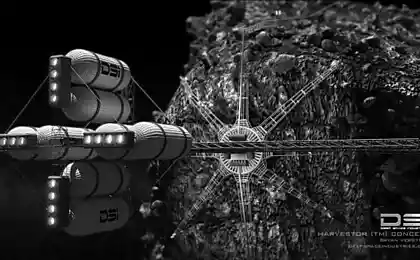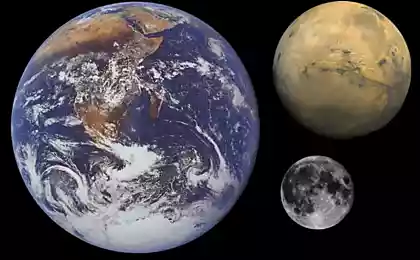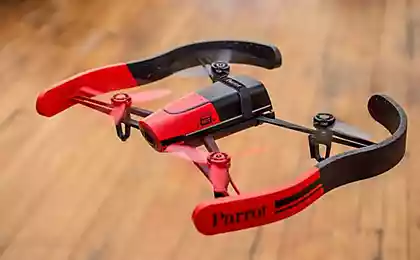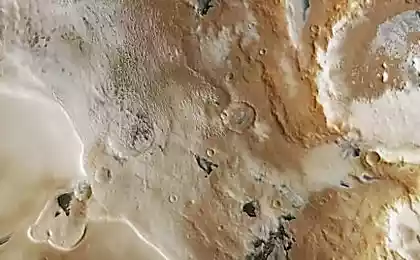251
NASA is developing drones to search for minerals on the moon and Mars
At first glance, the device in the picture may seem like an ordinary quadcopter, but this robotic aircraft NASA will be designed “to search for and collect soil samples on other planets and in places where conventional ground rovers will not be able to reach.”
The new drone was developed by Swamp Works engineers working at NASA's Kennedy Space Center in Florida. The main task of a compact autonomous flying machine will be exploration.
“The first step towards being able to exploit resources on Mars or asteroids will be to actually find those resources,” explains Rob Mueller, who is working on the project.
“Resources are likely to be located in hard-to-reach places and in areas of permanent shadow. In craters, for example. The walls of some craters have angles of 30 degrees or more, and their conquest is far beyond the capabilities of conventional ground rovers.”
The solution for NASA is to use Extreme Access Flyers. These flying vehicles, similar to conventional quadcopters, “will be able to move in darkened areas of craters and collect soil samples for further analysis for signs of solid water to be carried out by an orbiting spacecraft.” Unlike terrestrial drones, space drones will operate on the basis of compact gas turbine engines, because the alien atmosphere of Mars and, for example, the moon is not very suitable for the operation of traditional bladed engines.
It is possible that several such drones will be delivered to the surface of other planets along with landers that will be used by compact scouts as a landing base and navigation center. The lander will also be used as a refueling base where drones can replace and recharge their batteries and fuel tanks between reconnaissance missions. Speaking of fuel, NASA hopes that drone engines will run on fuel from oxygen or water vapor. In theory, this would allow drones to resupply themselves from the surface of the planet itself.
In addition to scouting for craters for water and other elements that can be processed into fuel for larger spacecraft, as well as air for breathing, scouts will explore lava tubes (channels) that are found on Mars and the Moon and that can also be found in many volcanic regions on Earth. Some of these canals can be up to 9 meters or even more in diameter, so compact drones will be able to explore these channels and possibly even find suitable and safe places to settle people while traveling to Mars.
Development of the project of autonomous compact scouts began two years ago. Thanks to the rapid development of commercial drones, the team from NASA was able to adapt some of the already ready-made developments for the project, making things move faster.
“The control systems of compact unmanned multirotor aerial vehicles are not very different from those of spacecraft. Thanks to this, we quickly began to develop the right controller, explains Mike Dupuy, one of the developers of this project.
A team of engineers built several types of quadrcopters, ranging from the smallest, the size of a human palm, and ending with larger ones - one and a half meters in size. All of them work on the basis of compact gas turbine engines.
NASA believes that this is the size of the drone is likely to be used in future missions related to Mars and the moon. It is unclear how soon such missions will start. published
P.S. And remember, just by changing your consciousness – together we change the world!
Source: hi-news.ru/technology/v-nasa-razrabatyvayut-dronov-dlya-poiska-poleznyx-iskopaemyx-na-lune-i-marse.html
The new drone was developed by Swamp Works engineers working at NASA's Kennedy Space Center in Florida. The main task of a compact autonomous flying machine will be exploration.
“The first step towards being able to exploit resources on Mars or asteroids will be to actually find those resources,” explains Rob Mueller, who is working on the project.
“Resources are likely to be located in hard-to-reach places and in areas of permanent shadow. In craters, for example. The walls of some craters have angles of 30 degrees or more, and their conquest is far beyond the capabilities of conventional ground rovers.”
The solution for NASA is to use Extreme Access Flyers. These flying vehicles, similar to conventional quadcopters, “will be able to move in darkened areas of craters and collect soil samples for further analysis for signs of solid water to be carried out by an orbiting spacecraft.” Unlike terrestrial drones, space drones will operate on the basis of compact gas turbine engines, because the alien atmosphere of Mars and, for example, the moon is not very suitable for the operation of traditional bladed engines.
It is possible that several such drones will be delivered to the surface of other planets along with landers that will be used by compact scouts as a landing base and navigation center. The lander will also be used as a refueling base where drones can replace and recharge their batteries and fuel tanks between reconnaissance missions. Speaking of fuel, NASA hopes that drone engines will run on fuel from oxygen or water vapor. In theory, this would allow drones to resupply themselves from the surface of the planet itself.
In addition to scouting for craters for water and other elements that can be processed into fuel for larger spacecraft, as well as air for breathing, scouts will explore lava tubes (channels) that are found on Mars and the Moon and that can also be found in many volcanic regions on Earth. Some of these canals can be up to 9 meters or even more in diameter, so compact drones will be able to explore these channels and possibly even find suitable and safe places to settle people while traveling to Mars.
Development of the project of autonomous compact scouts began two years ago. Thanks to the rapid development of commercial drones, the team from NASA was able to adapt some of the already ready-made developments for the project, making things move faster.
“The control systems of compact unmanned multirotor aerial vehicles are not very different from those of spacecraft. Thanks to this, we quickly began to develop the right controller, explains Mike Dupuy, one of the developers of this project.
A team of engineers built several types of quadrcopters, ranging from the smallest, the size of a human palm, and ending with larger ones - one and a half meters in size. All of them work on the basis of compact gas turbine engines.
NASA believes that this is the size of the drone is likely to be used in future missions related to Mars and the moon. It is unclear how soon such missions will start. published
P.S. And remember, just by changing your consciousness – together we change the world!
Source: hi-news.ru/technology/v-nasa-razrabatyvayut-dronov-dlya-poiska-poleznyx-iskopaemyx-na-lune-i-marse.html






















